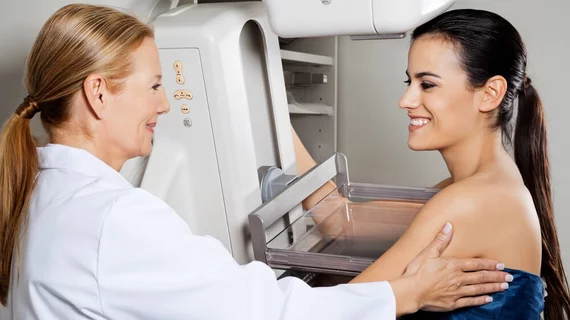Interval breast cancers linked to poorer prognoses in young women
Breast cancers that develop between routine screening exams are likely to grow more rapidly and be associated with poorer prognosis than cancers that are present at the time of screening mammography but go undetected, researchers have reported in JAMA Oncology.
Cancer diagnosed after a negative screening mammogram but before the patient’s next scheduled exam isn’t necessarily common, first author Anne Marie McCarthy, PhD, and colleagues wrote, but its 15 percent prevalence means identifying patients most at-risk for those “interval cancers” could save lives with additional imaging and intervention.
“These interval cancers include both cancers that were present during screening mammography but were missed on examination and rapidly growing cancers that present symptomatically and tend to have a poorer prognosis than cancers detected during screening,” McCarthy et al. wrote in JAMA. “Identifying women who are at high risk of breast cancer with a poorer prognosis despite regular screening mammography could enable targeted supplemental screening for women for whom screening mammography may not be sufficient.”
In these cases, the authors said, a poor prognosis is indicated by red flags like distant metastases, cancer-positive regional lymph nodes, larger HER2-negative invasive cancers and receptor-positive cancers.
McCarthy and her team evaluated data from 306,028 women in the PROSPR consortium, which includes data from hospitals in New Hampshire, Massachusetts, Philadelphia and Vermont. Women recruited for the study were above 40 years old, had no prior diagnosis of breast cancer and had received screening mammography between 2011 and 2014.
In their analysis, the researchers found that while the positive predictive value of mammography results seemed to depend on patient age and family history rather than breast density, the negative predictive value relied on breast density rather than patient age or history. Historically, the authors wrote, breast density has been heralded as the primary factor for identifying women who need supplemental screening.
Women with dense breasts had twice the odds of receiving a cancer diagnosis than women with non-dense breasts, according to the research—regardless of prognosis.
“Cases of cancer diagnosed after screening mammography with negative results were more likely to be associated with a poor prognosis than those diagnosed after mammography with positive results,” the authors wrote, noting 43.8 percent and 26.9 percent likelihood, respectively.
Though age and family history weren’t significantly associated with cancer diagnosis post-negative screening results, they said, younger women were more likely to be diagnosed with cancer with a poorer prognosis.
“Younger age is predictive of interval breast cancer with a poor prognosis,” McCarthy and colleagues wrote. “Although the rate of breast cancer after negative mammography results is small, the likelihood that such cases will be associated with a poor prognosis highlights the need to improve early detection for these women.”

